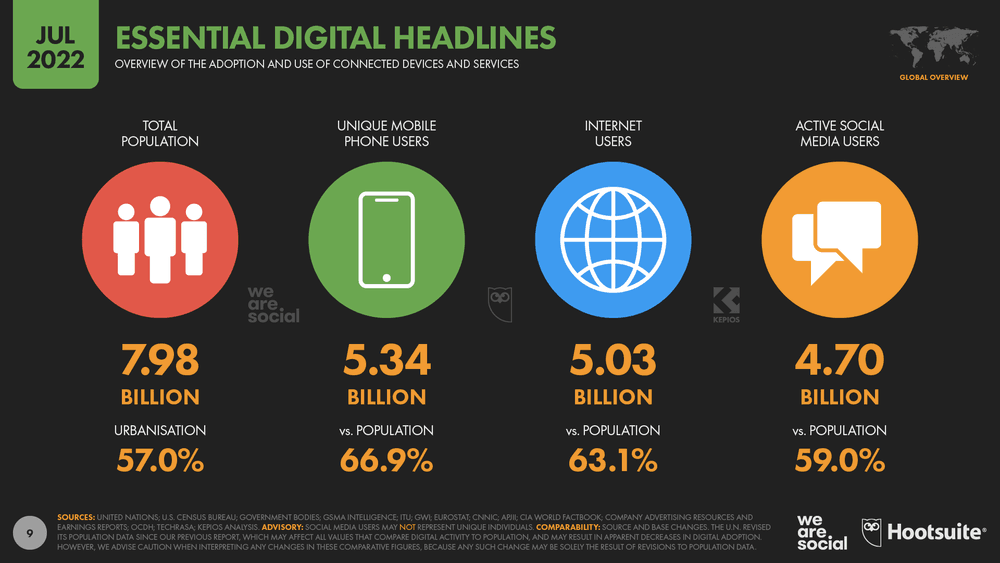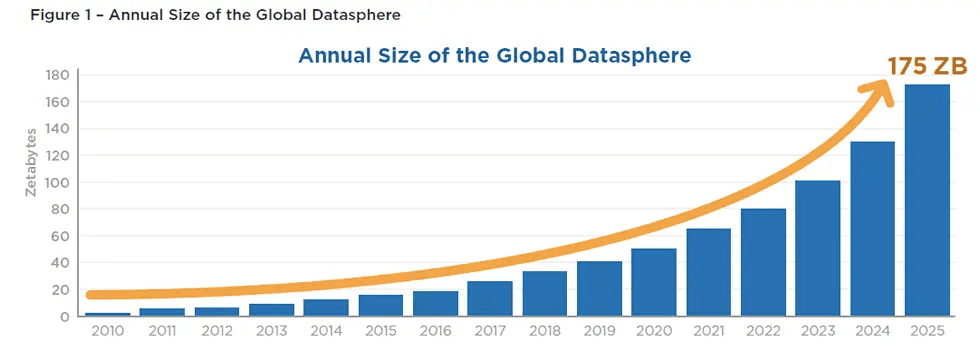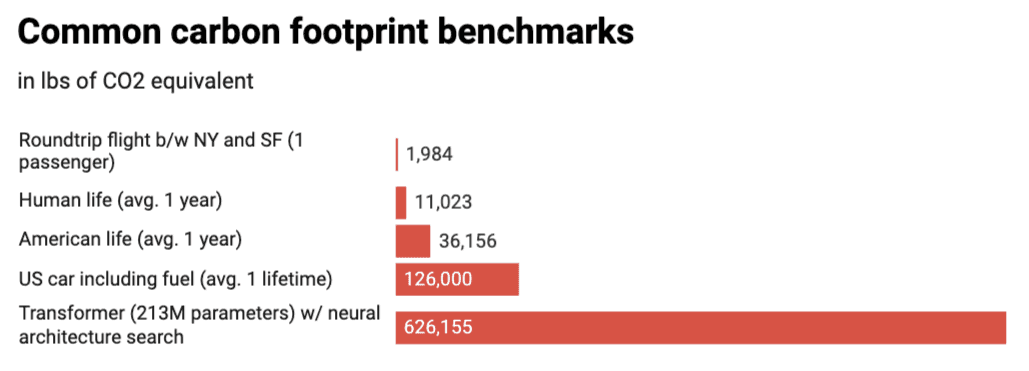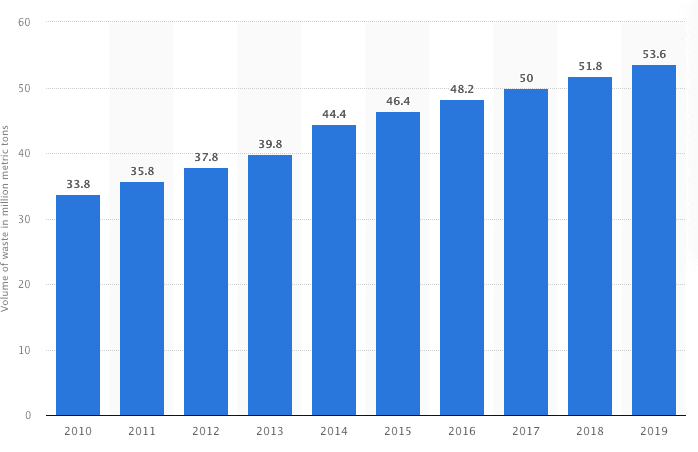
Given the gravity of the climate crisis, every industry is compelled to assess its potential impact on the planet and find ways to lower its environmental footprint. The digital world, and its most precious commodity, data, shouldn’t be an exception.
While digital technologies are frequently seen as critical drivers to meet the objectives of the Paris Agreement and deliver the Sustainable Development Goals, an increasing number of studies are alerting us to the significant climate and environmental impact of our digital activities.
From carbon-intensive mining activities and manufacturing operations to increasing electricity demand from data centers and product obsolescence that results in tonnes of e-waste, a comprehensive environmental audit of digital technologies is crucial to understanding the sector’s impact on climate change and biodiversity loss.
The goal of this article is to introduce the main sources that contribute to the environmental impact of digital technologies. The analysis covers all the activities involved in the lifespan of digital devices, from manufacturing and distribution to usage and disposal, as well as the infrastructure that makes possible the storage, transmission, and processing of data, such as telecommunication cables, and data centers. Drawing from most recent studies, the article is conceived as a lightweight introduction to raise awareness of the environmental footprint of digital technologies and data.
The Environmental Footprint of Digital Technologies: The Quest for a Holistic Approach
The first step to advancing a green and sustainable digital world is to assess the sector’s environmental footprint. However, although research on the topic has been gaining momentum recently, auditing the digital world is still an extremely complex task.
Data availability is one of the main challenges to advancing robust studies. It’s widely acknowledged the difficulty of regulating emerging technologies. Policy-makers often struggle to strike a balance between enabling innovation and protecting society from unexpected risks from new technologies. This tension explains why the digital world remains highly unregulated.
This lack of regulation is especially acute when it comes to addressing the environmental impact of digital technologies. The absence of a sustainability-oriented regulatory framework means that companies are often relieved from the obligation to adopt environmental standards, as well as to disclose data about the environmental impacts of their activities.
Despite recent progress to improve corporate transparency, there’re still significant data gaps and blind spots in the evidence on environmentally-relevant digitalization impacts.
The lack of data translates into methodological limitations, which ultimately affects the way scholars have addressed the question of the environmental impact of digital technologies. Numerous approaches have been adopted to quantify and assess the environmental impact of digital technologies. In particular, studies may differ on the following aspects:
- The hardware components beyond digital devices included in the analysis. This refers to the required equipment for the internet to work, such as data transmission networks, data centers, and sensor technology.
- The environmental impacts that comprise the so-called environmental footprint. Most studies focus on energy demand or greenhouse gas emissions (i.e. carbon footprint). However, it’s important to assess other non-energy impacts that add up to the digital environmental footprint too, such as water consumption, land degradation, and biodiversity loss.
- The phases of the digital device's lifespan included in the analysis. These are namely, manufacturing, distribution, use, or end-of-life phases.
With the current state of the industry, it’s difficult to make a comprehensive assessment of the environmental footprint of digital technologies. Despite the increasing interest in the issue in recent years, and the development of new methodologies, a holistic approach to evaluating negative impacts is still missing.
Explaining the Environmental Footprint of Data Technologies
In this section, we’ll introduce the different elements that contribute to the environmental impact of data. Drawing from existing sources, we will cover the environmental footprint of digital devices throughout the different life cycle phases, as well as the infrastructure required for digital devices to work correctly.
1. Manufacturing
Digital devices, such as desktops, laptops, tablets, and smartphones, are the gates for the internet. The rapid digitalization of society is consistent with the increase in digital devices. Estimates suggest that there will be 29.3 billion networked devices by 2023, up from 18.4 billion in 2018. This equals 3.6 networked devices per capita by 2023. Moreover, following the development of the so-called Internet of Things (IoT), IDC predicts that there will be 55.7 billion connected IoT devices by 2025.

Source: Global Digital Overview July 2022 DataReportal
A growing number of studies raise concerns about the environmental footprint associated with the massive manufacturing of digital devices. Studies estimate that this phase dominates the carbon footprint, water consumption, and resource depletion throughout the products’ whole life cycle.
In particular, two areas deserve special consideration: mining activities, and the production process.
Mining
Digital devices– as well as green technologies, such as solar panels, wind turbines, and electric vehicles– are highly dependent on a considerable number of critical materials to function, including minerals, metals, and, most particularly, rare earth elements. For example, most smartphones can carry roughly 80% of the stable elements on the periodic table, including most of the 17 rare-earth elements.

Source: Visual Capitalist
It takes an enormous amount of energy to pull critical material out of the earth. Once ores are above ground, they often need to be refined, so as to purify and separate the desired element from the rest of the aggregate. Refinement is particularly challenging and resource-intensive in the case of rare earth elements. Mining just tiny quantities of these elements requires removing many tonnes of rock. This process involves multiple chemical treatments and purification methods, which often result in land and water degradation.
The digital and green transitions will inevitably require a massive increase over existing levels of material extraction. This trend is likely to have severe implications for the environment, as the mining and refining of raw materials have already become a big driver of ecosystem collapse, water stress, biodiversity loss, and carbon emissions.
Production
Once critical minerals are extracted and processed, they are shipped to manufacturing facilities, where the production of hardware takes place.
The manufacturing of digital devices is an energy-demanding process, significantly higher than the use phase. Among the different activities, the production of semiconductors, sometimes referred to as integrated circuits or microchips, requires vast amounts of resources.
Despite the continuous efforts to increase energy efficiency during manufacturing, the energy and material gains are not enough to outweigh the negative environmental impacts, given the high rates of production and consumption. Accelerating product-innovation cycles, targeted advertising, and product obsolescence are also contributing factors to the growth of digital manufacturing, and hence its increasing environmental footprint.
Manufacturing also has a major influence on the water footprint of digital devices. Complex digital devices like laptops and smartphones are composed of many pieces created in multiple steps, and each step requires water.
Moreover, manufacturing activities create wastewater that is released into surrounding waterways. To limit the presence of pollutants and meet environmental standards, wastewater has to be diluted with clean water before entering the waterway. In total, the water required to make a single smartphone, including mining activities, is estimated at 3,190 gallons (12,760 liters).
2. Distribution
Unlike the food at your favorite restaurant, the chances of your smartphone being ‘locally produced’ are very low. From mines in the Democratic Republic of Congo and Chile and manufacturing facilities in Taiwan and China to distribution sites in the US and consumer stores across Western countries, the production and distribution of digital devices rely on a highly globalized and fragmented supply chain.
The complexity of the digital supply chain means that the final digital products have to be packaged and travel long distances before they end in consumers’ hands. Whether ships, airlines, railroads, or trucks, the transportation of digital devices around the world comes with an environmental footprint, namely in the form of carbon emissions from the burning of fossil fuels.
Another concerning issue is the environmental impact of e-commerce. The covid-19 pandemic has consolidated online shopping, with important implications for supply chains. Further research is required to understand whether online shipping, including the delivery of digital technologies, leads to additional carbon emissions from transportation.
3. Usage
In a nutshell: the digital world is about processing, transferring, and storing data. As the number of internet users increases, so does the number of digital devices, online services, and applications. This trend exacerbates energy demand and the environmental footprint of the internet, despite the progress in energy efficiency and the progressive phasing out of fossil energy.
Besides the energy required to keep all of our digital devices charged and running, three other aspects are important to consider when assessing the environmental footprint of our online activity: data centers, large scale machine learning, and network infrastructure.
Data centers
The digitalization of society will lead to not only an increasing number of digital devices but also an increase in worldwide data traffic. The total volume of data is expected to reach 175 Zettabytes by 2025, with cloud computing applications driving the majority of this growth.

Source: IDC Datasphere whitepaper
Despite the immaterial taste that the word ‘cloud’ has, the truth is that the cloud is heavily rooted in physical hardware. The idea is that data can be stored and processed in specialized, shared data centers around the world, and accessed online via web-based interfaces.
As more services and applications are turning to cloud providers, data centers are rapidly becoming the backbone of the digital world. This trend has raised concern about the rapid growth in energy use of data centers.
Several studies suggest that, despite efficiency gains in data center design and operations, the energy bill of data centers is likely to increase as a result of the rapid demand for cloud services from data-intensive technologies, such as video streaming, cloud gaming, social networks, autonomous cars, cryptocurrencies, IoT devices, virtual realities, and artificial intelligence systems (see next section).
Besides the carbon footprint of data centers, there are also growing concerns about the water required by cooling systems to keep heat under control inside data centers.
Large-Scale Machine Learning
The release of ChatGPT in late 2022 by OpenAI is having far-reaching implications for nearly every industry. ChatGPT is a highly advanced AI system that can produce highly accurate responses in a conversational way.
ChatGPT belongs to the family of large language modes (LLM) that, combining massive amounts of text data, natural language processing, and deep learning techniques, can perform a wide variety of language-based tasks with high accuracy, including text generation, machine translation, and question answering.
Since its launch, ChatGPT has generated a lot of buzz about the multiple ways it will change our society. However, if LLMs are believed to dominate the next AI revolution, it’s critical that we first assess the operational energy required and environmental costs of using these models. Yet further research is required, some scholars have already tried to answer this question.
If we stick to the carbon footprint of LLMs, we have to distinguish the carbon footprint from training the model, and the carbon footprint from running inference with the model.
As for the first element, researchers have found that the computational and environmental costs of training LLMs grow proportionally to model size and considerably increase when additional tuning steps are adopted to improve the model’s accuracy.
For example, in 2019 it was estimated that training an LLM with 213 million parameters can emit more than 626,000 pounds of carbon dioxide equivalent, which is nearly five times the lifetime emissions of the average American car, including those associated with manufacturing.
The carbon footprint of ChatGPT –based on the GPT-3 (Generative Pre-trained Transformer) model, consisting of 175 billion parameters– is hence likely to be much higher.
Considering that these models are often trained recursively to improve their results and update them with new data, the carbon footprint can be extremely high, despite the continuous improvements in energy efficiency.

Chart: MIT Technology Review. Source: Strubell et al.
This is only the cost of training the model. But once these models are trained, they still require energy to generate responses based on the information provided by users. The total amount of energy and associated carbon emissions will vary depending on the number of requests and the strategy employed to handle requests. In the case of ChatGPT, it can be millions per day, as it is repeatedly crashing due to exceptionally high demands. For a preliminary analysis of the carbon footprint of ChatGPT, check out this article.
Ultimately, the total emissions from these AI systems will depend not only on the amount of electricity they require but also on the way that electricity is produced. For example, using solar or wind energy to run the systems will result in fewer emissions. However, it’s important to note that the manufacturing and deployment of green technologies are still costly to the environment.
In sum, it’s vital to include environmental considerations in the development of large-scale machine learning models and, more broadly, any kind of AI system.
Network Infrastructure
Network infrastructure is the hardware and software that enables network connectivity between end-user devices and data centers. Despite being the veins of the digital world, providing the infrastructure for data transmission, this wide array of components –from submarine cables and antennas to modems and routers, are often set aside when analyzing the environmental footprint of digital technologies.

How the Internet Travels Across Oceans. Source: New York Times
Given the important role network infrastructure will play in the deployment of the new 5G mobile communications standards and the IoT, there should be efforts to close this knowledge gap.
4. End-of-Life
A lasting issue when analyzing the environmental footprint of digital devices is the problem of e-waste. E-waste refers to electronic products that are unwanted, not working, and nearing or at the end of their useful life.
Current market patterns –characterized by higher production and consumption rates of digital devices, short life cycles due to product obsolescence, and few repair options– are fuelling the generation of e-waste.
In 2019, the world generated 53.6 million metric tons of e-waste, and only 17.4% of this was officially documented as properly collected and recycled.

Global e-waste generation 2010-2019. Source: Statista
E-waste contains precious materials and hazardous substances. Most scrapped devices end up in residual waste, which is later incinerated or exported illegally to countries of the global South, primarily Africa, and Asia. This has already led to severe water and air pollution, soil contamination, and adverse health impacts for workers and the local population.
Greening Data Science
Data science is emerging as a powerful weapon to tackle the climate crisis. The number of data-powered applications is rapidly growing, ranging from initiatives to monitor carbon emissions and identify climate-vulnerable regions to improve environmental sustainability in supply chains and implement precision agriculture to limit water use and soil degradation.
Notwithstanding these promising developments, additional efforts are imperative to reduce the environmental impact of the industry. In other words, more “Data Science for Green” is not enough; we also need more “Green Data Science.”
Fortunately, over the years, more and more data professionals are taking action to address the environmental footprint of data science. For example, in 2019, more than 1,000 Google employees publicly called the company to reduce its contributions to climate change.
Here is a non-exhaustive list of practices data professionals can implement to green the data science industry:
- Adopt a strategy to advance green data. An effective way to limit the environmental footprint of your organization is to implement a strategy aimed at raising awareness among employees of the impacts of certain daily business activities and advance responsible digital practices. For an illustrative example, check out the Guide to responsible digital best practices for organizations (in French), elaborated by the French Government and the Institute for du Númerique Responsable.
- Remove dark data. Many companies report that more than half of their data is dark data, that is, data collected by organizations that are unknown and unused. To avoid unnecessary storage and associated carbon emissions, companies could design dark data deletion protocols. An inspiring initiative is Digital Cleanup Day, which provides simple guidelines for organizations and individuals committed to reducing their ecological footprint.
- Choose sustainable cloud providers. You can prioritize cloud services offered by data centers located in carbon-friendly regions.
- Support Green AI. Conceived by computer researchers from the Allen Institute for AI, behind the idea of Green AI is the promotion of efficiency as an evaluation metric alongside accuracy when training machine learning models.
- Repair before you replace. Given the high number of emissions linked to manufacturing and distributing digital devices, extending their average lifetime by promoting repairability could save millions of tonnes of emissions and environmental damage.
DataCamp’s Approach
DataCamp believes in supporting grassroots and global green initiatives with free or highly subsidized access to our world-class education platform. Through our DataCamp Donates program, we’ve worked with a range of organizations with climate change-focused missions to upskill their teams. Through our platform, we can support all kinds of organizations and professionals to make a positive impact on the environment.
Some of our most notable successes are with NGOs such as CDP and Omenda. Through DataCamp Donates, both have had access to free data skills changing for their organizations.
CDP is a nonprofit climate research provider that drives companies and governments to reduce their environmental impact by motivating them to disclose and manage their data. With the help of DataCamp, CDP are able to quickly upskill their team members, allowing them to continue delivering market-leading environmental data products and services to many organizations.
Similarly, Omdena is transforming the way socially conscious, data-driven research projects are being conducted. By leveraging a global community of aspiring data professionals, Omdena and DataCamp get learners production-ready by freely giving them the skills and know-how to collaborate on some of the most important problems of our time and get solid credits to add to their CVs, all at zero cost to them
We are proud to count over nine additional environmental research nonprofits as DataCamp Donates partners, such as:
- Global Biodiversity Information Facility (GBIF)
- Green City Force
- SOIL Haiti
- Thames Estuary Partnership
- Zimbabwe Flying Labs
- WeAct for Environmental Justice
- The Rivers Trust
- Pacific Rim Conservation
- Council on Energy, Environment and Water (CEEW)
They are receiving small grants or scholarships to help their organization’s entry-level employees and volunteers become data literate. This will enable them to improve on the important work their organization already does to study the negative effects of climate change in communities worldwide where DataCamp learners and employees live and develop sustainable solutions.
At DataCamp, we believe it is important to be aware and mindful of the environmental impact of data and technology, and we actively work with organizations that are committed to environmental causes. Nonprofit organizations are welcome to apply to DataCamp Donates or schedule a demo with our Sales team to discover all the ways DataCamp can support their eco-conscious missions.
Conclusion
At the current state, it’s difficult to assume that digitalization will lead per se to environmental benefits. In fact, the opposite could be happening. As the “Digital Reset” report has recently highlighted, the digitization process is exacerbating environmental and social crises rather than solving them.
Digitalization is rapidly transforming the way we live together, and it’s regarded by governments worldwide as a key driver for economic growth, and even sustainability transformation.
However, the regulatory moves to advance this expansionist agenda are failing to address the question of how the digital economy is contributing to the environmental problems we’re facing. The digital transformation has to be steered in a way that mitigates its negative environmental impacts.
Environmental Impact of Data FAQs
How much data will be generated in the coming years?
The total volume of data is expected to reach 175 Zettabytes by 2025.
What is a smartphone made of?
While the combination of metals in a smartphone may vary, most smartphones can carry roughly 80% of the stable elements on the periodic table, including the majority of rare earth elements.
What are the main challenges to assessing the environmental footprint of digital devices?
There are significant data gaps and blind spots to accurately measure all the factors and activities that contribute to the environmental footprint of digital technologies. This limited information translates into methodological challenges that scholars struggle to address.
What is a data center?
A data center comprises two elements: servers, which carry out the data processing and storage, and support systems, such as power supply and cooling systems.
What is e-waste?
E-waste is electronic products that are unwanted, not working, and nearing or at the end of their “useful life.
